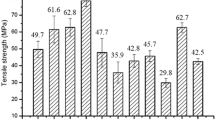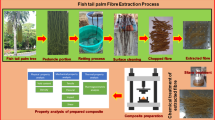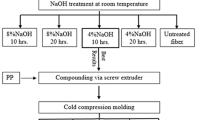Abstract
This work proposes a benzothiazole derivative bearing a silane moiety as a new coupling agent for polylactic acid (PLA) reinforced by date palm fibers (DPFs). The bio-composites are prepared by solution blending followed by melt compounding. From the samples produced, a complete characterization is performed including morphological, mechanical and thermal properties as a function of fiber content. The results show that the proposed fiber treatment is an easy and effective method to improve the interfacial properties and fiber dispersion leading to better material performance. For example, the addition of only 1 wt% of the dye–IPTMS to the bleached DPF not only improved the thermal stability of the biocomposites, but also led to a significant increase of the Young’s modulus at 7 wt% and higher torsion modulus up to 5 wt% (optimum value).










Similar content being viewed by others
References
Vicentini N, Gatti T, Salice P et al (2015) Covalent functionalization enables good dispersion and anisotropic orientation of multi-walled carbon nanotubes in a poly (L-lactic acid) electrospun nano fibrous matrix boosting neuronal differentiation. Carbon NY 95:725–730. https://doi.org/10.1016/j.carbon.2015.08.094
Lu T, Liu S, Jiang M et al (2014) Effects of modifications of bamboo cellulose fibers on the improved mechanical properties of cellulose reinforced poly(lactic acid) composites. Composites B 62:191–197. https://doi.org/10.1016/j.compositesb.2014.02.030
Kiziltas A, Nazari B, Gardner DJ, Bousfield DW (2014) Polyamide 6–cellulose composites: effect of cellulose composition on melt rheology and crystallization behavior. Polym Eng Sci 54:739–746. https://doi.org/10.1002/pen
Bagheriasl D, Carreau PJ, Riedl B et al (2016) Shear rheology of polylactide (PLA)–cellulose nanocrystal (CNC) nanocomposites. Cellulose 23:1885–1897. https://doi.org/10.1007/s10570-016-0914-1
Xie Y, Hill CAS, Xiao Z et al (2010) Silane coupling agents used for natural fiber/polymer composites: a review. Composites A 41:806–819. https://doi.org/10.1016/j.compositesa.2010.03.005
Demir H, Atikler U, Balko D (2006) The effect of fiber surface treatments on the tensile and water sorption properties of polypropylene–luffa fiber composites. Composites A 37:447–456. https://doi.org/10.1016/j.compositesa.2005.05.036
Abdulkhani A, Hosseinzadeh J, Ashori A et al (2014) Preparation and characterization of modified cellulose nanofibers reinforced polylactic acid nanocomposite. Polym Test 35:73–79. https://doi.org/10.1016/j.polymertesting.2014.03.002
Sawpan MA, Pickering KL, Fernyhough A (2011) Effect of fibre treatments on interfacial shear strength of hemp fibre reinforced polylactide and unsaturated polyester composites. Composites A 42:1189–1196. https://doi.org/10.1016/j.compositesa.2011.05.003
Tran TPT, Bénézet JC, Bergeret A (2014) Rice and Einkorn wheat husks reinforced poly(lactic acid) (PLA) biocomposites: effects of alkaline and silane surface treatments of husks. Ind Crops Prod 58:111–124. https://doi.org/10.1016/j.indcrop.2014.04.012
Mukherjee T, Sani M, Kao N et al (2013) Improved dispersion of cellulose microcrystals in polylactic acid (PLA) based composites applying surface acetylation. Chem Eng Sci 101:655–662. https://doi.org/10.1016/j.ces.2013.07.032
Goriparthi BK, Suman KNS, Mohan Rao N (2012) Effect of fiber surface treatments on mechanical and abrasive wear performance of polylactide/jute composites. Composites A 43:1800–1808. https://doi.org/10.1016/j.compositesa.2012.05.007
Laaziz SA, Raji M, Hilali E et al (2017) Bio-composites based on polylactic acid and argan nut shell: production and properties. Int J Biol Macromol 104:30–42. https://doi.org/10.1016/j.ijbiomac.2017.05.184
Huda MS, Drzal LT, Mohanty AK, Misra M (2008) Effect of fiber surface-treatments on the properties of laminated biocomposites from poly(lactic acid) (PLA) and kenaf fibers. Compos Sci Technol 68:424–432. https://doi.org/10.1016/j.compscitech.2007.06.022
Araújo A, Botelho G, Oliveira M, Machado AV (2014) Influence of clay organic modifier on the thermal-stability of PLA based nanocomposites. Appl Clay Sci 88–89:144–150. https://doi.org/10.1016/j.clay.2013.12.005
Dong Y, Ghataura A, Takagi H et al (2014) Polylactic acid (PLA) biocomposites reinforced with coir fibres: evaluation of mechanical performance and multifunctional properties. Composites A 63:76–84. https://doi.org/10.1016/j.compositesa.2014.04.003
Kawamura M, Sato K (2006) Magnetically separable phase-transfer catalysts. Chem Commun 4718–4719
Lee B, Im H, Luo H et al (2005) Synthesis and characterization of periodic mesoporous organosilicas as anion exchange resins for perrhenate adsorption. Langmuir 21:5372–5376
Cejas MA, Raymo FM (2005) Fluorescent diazapyrenium films and their response to dopamine. Langmuir 21:5795–5802
Britcher LG, Kehoe DC, Matisons JG, Swincer AG (1995) Siloxane coupling agents. Society 3110–3118. https://doi.org/10.1021/ma00113a013
Chollakup R, Smitthipong W, Kongtud W, Tantatherdtam R (2013) Polyethylene green composites reinforced with cellulose fibers (coir and palm fibers): effect of fiber surface treatment and fiber content. J Adhes Sci Technol 27:1290–1300. https://doi.org/10.1080/01694243.2012.694275
Boujmal R, Essabir H, Nekhlaoui S et al (2014) Composite from polypropylene and henna fiber: structural, mechanical and thermal properties. J Biobased Mater Bioenergy 8:246–252
Essabir H, Achaby ME, Hilali EM et al (2015) Morphological, structural, thermal and tensile properties of high density polyethylene composites reinforced with treated argan nut shell particles. J Bionic Eng 12:129–141
Ouarhim W, Bensalah M, Rodrigue D et al (2018) Production and characterization of high density polyethylene reinforced by eucalyptus capsule fibers. J Bionic Eng 15:558–566
Marwah R, Ibrahim NA, Zainuddin N et al (2014) The effect of fiber bleaching treatment on the properties of poly(lactic acid)/oil palm empty fruit bunch fiber composites. Int J Mol Sci 15:14728–14742. https://doi.org/10.3390/ijms150814728
Liu H, Zhang L (2000) Silylation of cellulose with trichlorosilane and triethoxysilane in homogeneous LiCl/N,N-dimethylacetamide solution. Chin J Polym Sci (Engl Ed 18:161–168
Sgriccia N, Hawley MC, Misra M (2008) Characterization of natural fiber surfaces and natural fiber composites. Composites A 39:1632–1637. https://doi.org/10.1016/j.compositesa.2008.07.007
Al-Kaabi K, Al-Khanbashi A, Hammami A (2005) Date palm fibers as polymeric matrix reinforcement: DPF/polyester composite properties. Polym Compos 26:604–613. https://doi.org/10.1002/pc.20130
El Mechtali FZ, Essabir H, Nekhlaoui S et al (2015) Mechanical and thermal properties of polypropylene reinforced with almond shells particles: impact of chemical treatments. J Bionic Eng 12:483–494
Al-Khanbashi A, Al-Kaabi K, Hammami A (2005) Date palm fibers as polymeric matrix reinforcement: fiber characterization. Polym Compos 26:486–497. https://doi.org/10.1002/pc.20118
Rosa MF, Medeiros ES, Malmonge JA et al (2010) Cellulose nanowhiskers from coconut husk fibers: effect of preparation conditions on their thermal and morphological behavior. Carbohydr Polym 81:83–92. https://doi.org/10.1016/j.carbpol.2010.01.059
Thomas MG, Abraham E, Jyotishkumar P et al (2015) Nanocelluloses from jute fibers and their nanocomposites with natural rubber: preparation and characterization. Int J Biol Macromol 81:768–777. https://doi.org/10.1016/j.ijbiomac.2015.08.053
Shih YF, Huang CC (2011) Polylactic acid (PLA)/banana fiber (BF) biodegradable green composites. J Polym Res 18:2335–2340. https://doi.org/10.1007/s10965-011-9646-y
Mofokeng JP, Luyt AS, Tábi T, Kovács J (2012) Comparison of injection moulded, natural fibre-reinforced composites with PP and PLA as matrices. J Thermoplast Compos Mater 25:927–948. https://doi.org/10.1177/0892705711423291
Senatov FS, Niaza KV, Zadorozhnyy MY et al (2016) Mechanical properties and shape memory effect of 3D-printed PLA-based porous scaffolds. J Mech Behav Biomed Mater 57:139–148. https://doi.org/10.1016/j.jmbbm.2015.11.036
Huda MS, Drzal LT, Misra M et al (2005) A study on biocomposites from recycled newspaper fiber and poly(lactic acid). Ind Eng Chem Res 44:5593–5601. https://doi.org/10.1021/ie0488849
Li Z, Luo G, Wei F, Huang Y (2006) Microstructure of carbon nanotubes/PET conductive composites fibers and their properties. Compos Sci Technol 66:1022–1029
Abdelmouleh M, Boufi S, Belgacem MN, Dufresne A (2007) Short natural-fibre reinforced polyethylene and natural rubber composites: effect of silane coupling agents and fibres loading. Compos Sci Technol 67:1627–1639. https://doi.org/10.1016/j.compscitech.2006.07.003
Oksman K, Skrifvars M, Selin J (2003) Natural fibres as reinforcement in polylactic acid (PLA) composites. Compos Sci Technol 63:1317–1324. https://doi.org/10.1016/S0266-3538(03)00103-9
Haafiz MKM, Hassan A, Zakaria Z et al (2013) Properties of polylactic acid composites reinforced with oil palm biomass microcrystalline cellulose. Carbohydr Polym 98:139–145. https://doi.org/10.1016/j.carbpol.2013.05.069
Pei A, Zhou Q, Berglund LA (2010) Functionalized cellulose nanocrystals as biobased nucleation agents in poly(l-lactide) (PLLA)—crystallization and mechanical property effects. Compos Sci Technol 70:815–821. https://doi.org/10.1016/j.compscitech.2010.01.018
Essabir H, Bensalah MO, Bouhfid R, Qaiss A (2014) Fabrication and characterization of apricot shells particles reinforced high density polyethylene based bio-composites: mechanical and thermal properties. J Biobased Mater Bioenergy 8:344–351. https://doi.org/10.1166/jbmb.2014.1447
Acknowledgements
This work was supported by MAScIR; Moroccan Foundation for Advanced Science, Innovation and Research, MESRSFC and CNRST, Morocco Grant No. 1970/15. The authors would like to thank Mr. Mehdi AitDahi for his fruitful technical support and assistance.
Author information
Authors and Affiliations
Corresponding author
Additional information
Publisher's Note
Springer Nature remains neutral with regard to jurisdictional claims in published maps and institutional affiliations.
Rights and permissions
About this article
Cite this article
Semlali Aouragh Hassani, FZ., Ouarhim, W., Raji, M. et al. N-Silylated Benzothiazolium Dye as a Coupling Agent for Polylactic Acid/Date Palm Fiber Bio-composites. J Polym Environ 27, 2974–2987 (2019). https://doi.org/10.1007/s10924-019-01585-x
Published:
Issue Date:
DOI: https://doi.org/10.1007/s10924-019-01585-x




